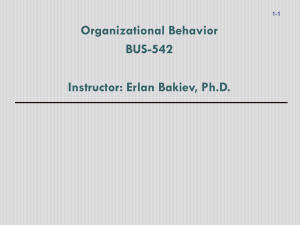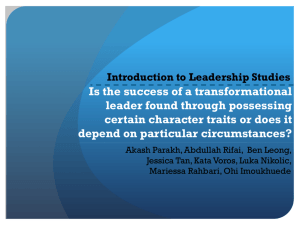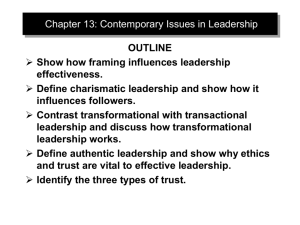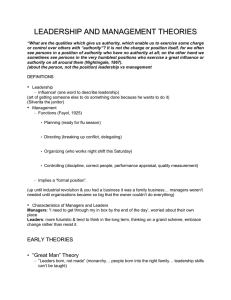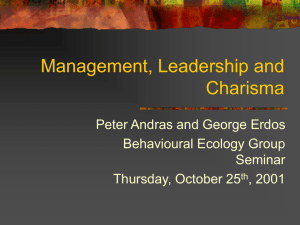Leadership Theories & Styles: Organizational Behavior
advertisement
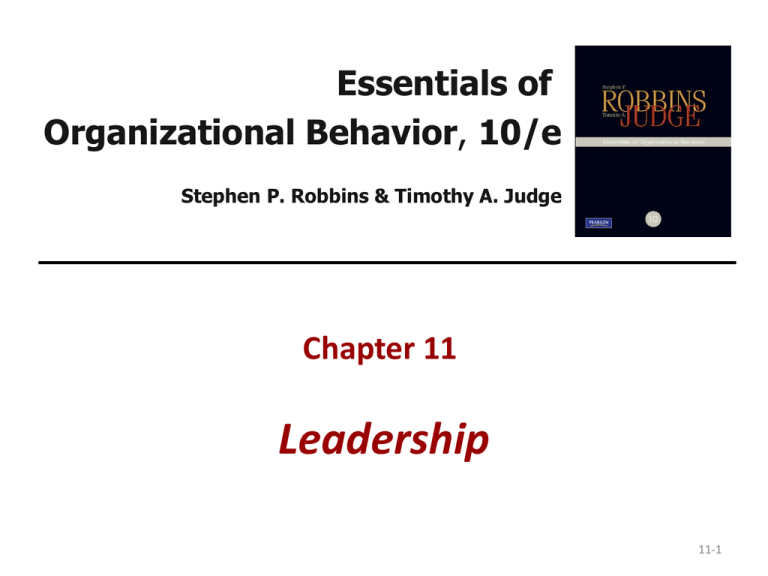
Essentials of Organizational Behavior, 10/e Stephen P. Robbins & Timothy A. Judge Chapter 11 Leadership 11-1 After studying this chapter, you should be able to: Define the leadership and contrast leadership and management. .1 Summarize the conclusions of trait and behavioral theories. .2 Assess contingency theories of leadership by their level of support. .3 Compare and contrast charismatic leadership, transformational leadership, and authentic leadership. .4 Identify when leadership may not be necessary. .5 Assess whether charismatic and transformational leadership generalize across cultures. .6 11-2 Leadership vs. Management Leadership About coping with change • Establish direction with a • vision. Align resources and inspire • workers to complete the vision. Management About coping with • complexity Brings about order and • consistency Draws up plans, structures, • and monitors results. Leadership is the ability to influence a group toward the achievement of a vision or a set of goals. 11-3 Traditional Theories of Leadership: Trait Theories Differentiate leaders from non-leaders by focusing on personal qualities and characteristics Extraversion has strongest relation to leadership – Conscientiousness and Openness to Experience also strongly – related to leadership Agreeableness and Emotional Stability are not correlated – with leadership 11-4 Traditional Theories of Leadership: Behavioral Theories Behaviors can be taught – traits cannot Leaders are trained – not born 11-5 Behavioral Theories: Ohio State Studies Developed two categories of leadership behavior: Initiating Structure Attempts to organize work, work relationships, and goals Consideration Concern for followers’ comfort, well-being, status, and satisfaction 11-6 Behavioral Theories: University of Michigan Studies Developed two dimensions of leadership behavior: Production Employee Oriented Oriented Emphasize the technical or task aspects of the job: people are means to an end Emphasize interpersonal relations and accept individual differences 11-7 Blake and Mouton’s Leadership Grid® Combination of Ohio State and University of Michigan studies: Concern for Production Concern for People Try to emphasize BOTH 11-8 Contingency Theories Attempts to match leadership style with work conditions: Fiedler Model • Leader-Member Exchange • (LMX) Theory 11-9 Fiedler Leadership Model Least-Preferred Co-worker (LPC) determines leadership style (fixed trait) Relationship oriented – Task oriented – Match leader’s style with degree of situational control: Leader-member relations – Task structure – Position power – 11-10 Fiedler Model: Matching Leaders to Situations Either change leaders or the situation to improve effectiveness 11-11 Leader-Member Exchange (LMX) Theory Leaders treat followers differently • In-group members: • Close to leader in attitude or personality – Have more of the leader’s attention – Get special privileges – Have higher performance ratings – Lower turnover – Greater satisfaction – 11-12 Leader-Member Exchange (LMX) Model While the leader does the choosing, it is the followers’ characteristics that drive the decision 11-13 Contemporary Approaches to Leadership Leaders as communicators • Framing the meaning of events • Leaders inspire followers through • words, ideas, and behaviors: Charismatic Leadership – Transformational Leadership – Authentic Leadership – 11-14 Charismatic Leadership Attributions of heroic leadership abilities when followers observe certain behaviors: Vision – Personal Risk-taking – Sensitivity toward Followers – Extraordinary Behaviors – 11-15 Charismatic Leaders: Born or Made? Charisma can be created by: Developing an aura of charisma – Be optimistic • Be passionately enthusiastic • Commute with body, not just words • Drawing others in – inspire others – Tapping into emotions – bring out the – potential in others 11-16 How Charismatic Leaders Influence Followers Articulate an appealing vision • Communicates a new set of • values Model behaviors for those values • Express dramatic behavior • 11-17 Charisma and Situational Dependency Charisma strongly correlated to high • performance and satisfaction Best used when: • Environment is uncertain or stressful – Ideology is involved – Most closely associated with upper level • executives 11-18 The Potential Dark Side of Charismatic Leadership Use organizational resources • for personal benefit Remake companies in their • own image Allow self-interest and • personal goals to override organization’s goals 11-19 Transformational Leadership Transactional leaders - motivate their followers • in the direction of established goals by clarifying role and task requirements Transformational leaders - inspire followers to • transcend their own self-interests for the good of the organization 11-20 Full Range of Leadership Model 11-21 Why Transformational Leadership Works Creativity Followers are encouraged to be more innovative and creative Goals Followers pursue more ambitious goals and have more personal commitment to them Vision Engenders commitment from followers and greater sense of trust 11-22 Transformational Vs. Charismatic Leadership Both positively related to motivation, • satisfaction, performance, effectiveness, and profitability Transformational leadership MAY be a • broader concept than charisma The two forms may be the same • 11-23 Authentic Leadership: Ethics as the Basis for Leadership? Authentic leaders know who they are, what • they believe in and value, and act on those values and beliefs openly and candidly Create trust – Encourage open – communication Socialized Charismatic – Leadership 11-24 Challenges to the Leadership Construct Attribution Theory of Leadership • Performance outcomes are attributed to leaders actions – Appearance has more to do with leadership than – outcomes Substitutes and Neutralizers • Organizational variables can neutralize the leader’s – influence or act as substitutes for leadership Leader becomes irrelevant – 11-25 Finding and Creating Effective Leaders Selection: • Personality tests for leadership traits – Interviews to match relevant situation-specific experience – to job situation Training: • Train those willing to change their behavior – Teach general management skills – Teach charismatic and transformational leadership skills – – greatest organizational outcomes result 11-26 Global Implications GLOBE Leadership Project Results: Brazil – Leaders are participative and humane France – Bureaucratic, task-oriented, and autocratic Egypt – Participative but status-aware China – Initiating structure and consideration important: status differences but participation valued Charisma and transformational leadership important in all 11-27 Implications for Managers Leaders influence group performance • Leadership success depends somewhat on • having “the right stuff” Leadership depends on the situation • Transformational skills becoming more • important Select and train based on traits and • qualities 11-28 Keep in Mind… Leaders can influence a group toward • the achievement of goals Best leaders are ethical and authentic in • addition to being charismatic In most cultures, charisma and vision are • valued – although their means of expression may differ 11-29 Summary Defined the leadership and contrasted leadership and management. .1 Summarized the conclusions of trait and behavioral theories. .2 Assessed contingency theories of leadership by their level of support. .3 Compared and contrasted charismatic leadership, transformational leadership, and authentic leadership. .4 Identified when leadership may not be necessary. .5 Assessed whether charismatic and transformational leadership generalized across cultures. .6 11-30


